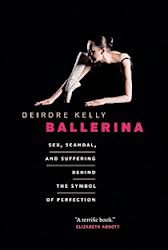Long Island Pulse Magazine reviews Ballerina: Sex, Scandal and Suffering Behind the Symbol of Perfection
Posted by Deirdre | Filed under Blog
Reviewed by Terri Schlichenmeyer (a.k.a. The Bookworm)
Human beings can fly.
Or, at least it seems that way. One minute, the ballerina is on-stage and the next minute, she’s in the air, her feet pointed at impossible angles and her fingers gracefully indicating where she’ll land – when she’s done flying.
She’s so lovely. So graceful. Completely elegant and impossibly ethereal. And as you’ll see in the new book “Ballerina” by Deirdre Kelly, she’s probably also hungry and sore.
Though ballet sometimes seems like an ancient art, ballerinas weren’t considered as dance professionals until the seventeenth century.
Then, ballet was mostly for men, specifically kings.
Louis XIII wrote ballets. Louis XIV danced until he became too rotund. For male royalty, ballet was a “way of life” but for female subjects of the King, to be a dancer was to also be a courtesan or a prostitute. Women of low birth, in fact, learned to dance (always with both feet on the floor, never jumping) to elevate their status.
But that wasn’t necessarily a bad thing. Ballerinas were independent women, running their own businesses, so to speak. At a time when women were possessions, ballerinas were emancipated from their families. Some became rich; others – like Marie-Anne de Cupis de Camargo – became famous.
It was Camargo who changed the way ballerinas danced, by perfecting “vigorous” leaps and movements. Men on stage, at that time, were perceived as “disgusting.”
By the mid-to-late 1800s, the popularity of ballet changed the way ballerinas were made. No longer could a graceful woman simply call herself a dancer; instead, training started when ballerinas were very young and growing dancers were often forced to wear apparatuses to mold their bodies. Girls had to pay for their costumes from an already-small salary. Being a dancer was glamorous but also dangerous: gaslight and gauzy skirts were a deadly combination.
At the turn of the twentieth century, the dance pirouetted: no longer all about the ballerina, it was then choreographer-driven. Dancers were often fired for their weight. Anorexia was near-mandatory. Marriage and children were discouraged.
Within the last few decades, however, ballerinas have banded together to change the industry again. Weight and curves are acceptable now, as are ballerinas of color. Still, according to the author, there are many issues to grand jeté past.
So you’ve had your season tickets to the ballet for months now. You wanted to be Clara, or a Sugarplum Fairy when you were a kid. If your toes still carry calluses, you’ll love this book.
Here, though the history of the ballerina isn’t pretty, author Dierdre Kelly doesn’t candy-coat it. She starts at the dance’s sordid past and travels to a present that’s only recently, marginally better. There are also some surprises in this book, historically speaking, and some winces: ballet, as you’ll see, almost needs to be an Olympic sport.
Be aware that, because ballet has deep roots in Europe, there’s a lot of non-English language in this book. Also, it’s definitely not a book for aspiring ballerinas. But if you’re antsing for the dancing, “Ballerina” raises the barre.

